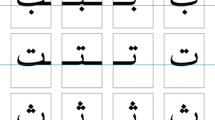Abstract
Arabic optical character recognition (OCR) has been an active field of research for decades. Yet, it has limited application domains constrained to printed text. This is partly due to high time complexity of Arabic OCR algorithms. Accelerating these algorithms allows for applications in real-time assistive technologies, office automation, and portable devices. Modern programmable hardware devices like FPGAs have numerous logic resources that allow parallel implementations of many algorithms. In this paper, we investigate implementing the feature extraction and classification stages of handwritten Arabic words on FPGAs. We study the performance and cost of four commonly-used feature extraction techniques and neural network classifiers on images from the IFN/ENIT database of handwritten Arabic words. The most efficient feature extraction technique and the best neural network found are implemented. Multiple FPGA implementations with varying cost and performance are evaluated. An implementation that only consumes about one quarter of the FPGA resources is 20 times faster than the software implementation and is less accurate by only 2.8 %.





Similar content being viewed by others
References
Impedovo, S., Ottaviano, L., Occhinegro, S. (1991). Optical character recognition—a survey. International Journal of Pattern Recognition and Artificial Intelligence, 5(1), 1–24.
Lewis, M. P. (2009). Ethnologue: languages of the world. Dallas: SIL Int’l.
Lorigo, L.M., & Govindaraju, V. (2006). Offline Arabic handwriting recognition: a survey. IEEE Transaction on Pattern Analysis Machine Intelligence, 28(5), 712–724.
Märgner, V., & El-Abed, H. (2011). ICDAR 2011 Arabic handwriting recognition competition. In 11th international conference document analysis recognition (pp. 1444–1448).
Märgner, V., & El-Abed, H. (2009). ICDAR 2009 Arabic handwriting recognition competition. In 10th international conference document analysis recognition (pp. 1383–1387).
Khorsheed, M. (2002). Off-line Arabic character recognition—a review. Pattern Analysis and Applications, 5(1), 31–45.
Rice, S. (1996). Measuring the accuracy of page-reading systems. PhD Dissertation, University of Nevada.
Suyyagh, A., & Abandah, G. (2013). FPGA parallel recognition engine for handwritten Arabic words. Tech. Rep. http://www.abandah.com/gheith/Suyyagh.pdf.
Beg, A. (2008). An efficient realization of an OCR system using HDL. In 2008 world congress in computer science, computer engineering, and applied computing.
Al-Marakeby, A., Kimura, F., Zaki, M., Rashid, A. (2013). Design of an embedded Arabic optical character recognition. Journal Signal Processing Systems, 70(3), 249–258.
Toosizadeh, N., & Eshgi, M. (2005). Design and implementation of a new Persian digits OCR algorithm on FPGA chips. In 13th conference European signal processing.
Moradi, M., Pourmina, M., Razzazi, F. (2010). A new method of FPGA implementation of Farsi handwritten digit recognition. European Journal of Scientific Research, 39(3), 309–315.
Razak, Z., Zulkiflee, K., Salleh, R., Yaacob, M., Tamil, M. (2007). A real-time line segmentation algorithm for an offline overlapped handwritten Jawi character recognition chip. Malaysian Journal of Computer Science, 20(2), 171–182.
Razak, Z., Zulkiflee, K., Salleh, R., Noor, N.M., Yaacob, M. (2009). Off-line handwritten Jawi character segmentation using histogram normalization and sliding window approach for hardware implementation. Malaysian Journal of Computer Science, 22(1), 34–43.
Ahmadi, A., Abedin, M.D., Kamimura, K., Shirakawa, Y., Mattausch, H.J., Koide, T. (2004). Associative memory based hardware design for an OCR system and prototyping with FPGA. In 3rd international workshop on nanoelectronics for tera-bit information processing (pp. 40–41).
Srinivasan, S., Zhao, L., Sun, L., Fang, Z., Li, P., Wang, T., et al. (2010). Performance characterization and acceleration of optical character recognition on handheld platforms. In IEEE international symposium workload characterization (pp. 2–4).
Pechwitz, M., Maddouri, S.S., Märgner, V., Ellouze, N., Amiri, H. (2002). IfN/ENIT–database of handwritten Arabic words. In Colloque international francophone sur l’ecrit et le document (pp. 127–136).
Al-Khateeb, J., Ren, H., Jiang, J., Jianmin, I., Stan, S., El-Abed, H. (2008). Word-based handwritten Arabic scripts recognition using DCT features and neural network classifier. In 5th international multi-conference systems, signals and devices (p. 15).
Altera Website. DE2-70 development and education board. http://www.altera.com/education/univ/materials/boards/de2-70/unv-de2-70-board.html. Accessed 10 Aug 2013.
Abandah, G., & Khedher, M. (2009). Analysis of handwritten Arabic letters using selected feature extraction techniques. International Journal of Computer Processing of Languages, 22(1), 49–73.
Noaparast, K., & Broumandnia, A. (2009). Persian handwritten word recognition using Zernike and Fourier-Mellin moments. In 5th international conference sciences of electronic technologies of information and telecommunications.
Cho, N.I., & Lee, S.U. (1991). Fast algorithm and implementation of 2-D discrete cosine transform. IEEE Transactions on Circuits System, 38(3), 297–305.
Ebrahimpour, R., Davoudi Vahid, R., Nezhad, B.M. (2011). Decision templates with gradient based features for Farsi handwritten word recognition. International Journal of Hybrid Information Technology, 4(1), 1–12.
Hu, M. (1962). Visual pattern recognition by moment invariants. IRE Transactions on Information Theory, 8(2), 179–187.
Author information
Authors and Affiliations
Corresponding author
Rights and permissions
About this article
Cite this article
Suyyagh, A., Abandah, G. FPGA Parallel Recognition Engine for Handwritten Arabic Words. J Sign Process Syst 78, 163–170 (2015). https://doi.org/10.1007/s11265-013-0848-x
Received:
Revised:
Accepted:
Published:
Issue Date:
DOI: https://doi.org/10.1007/s11265-013-0848-x




